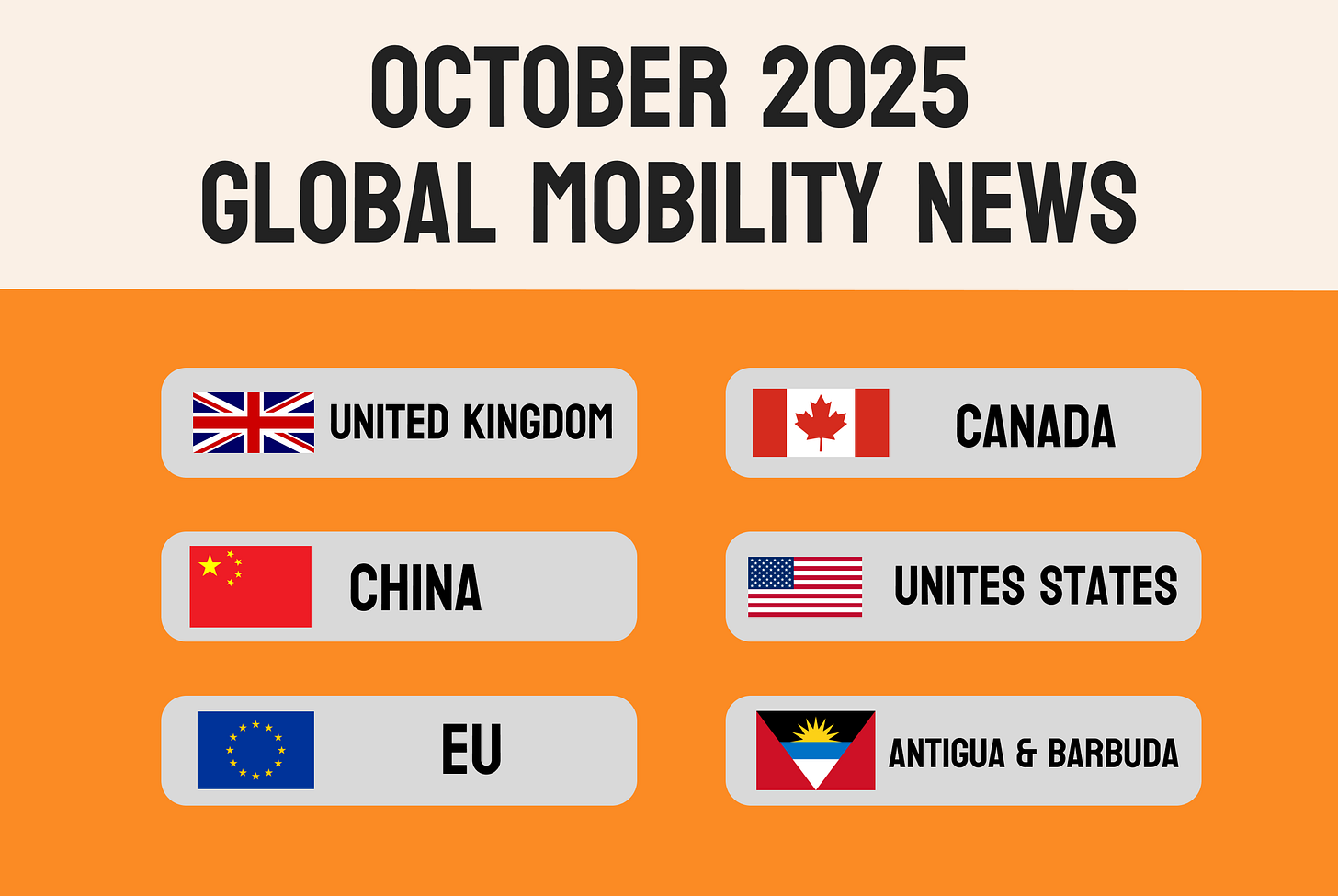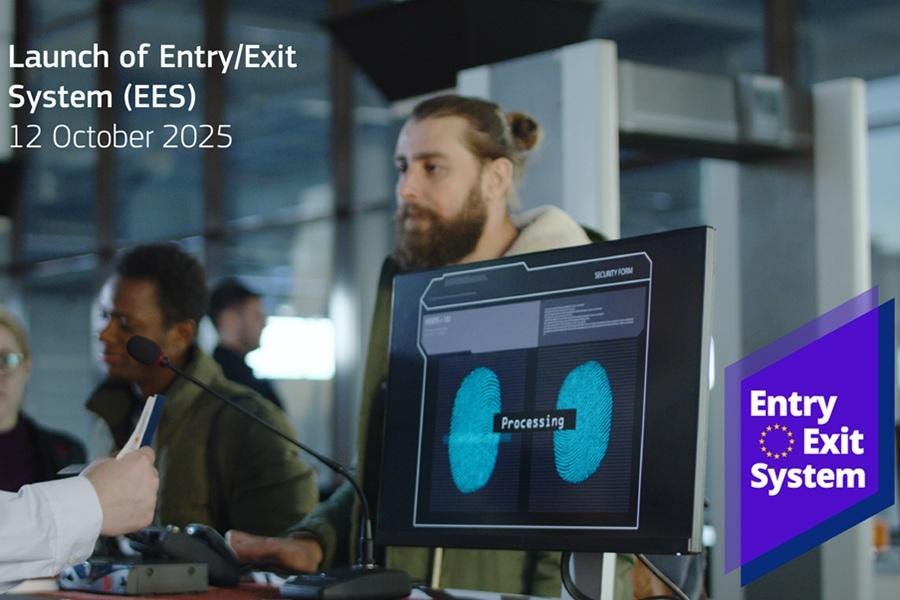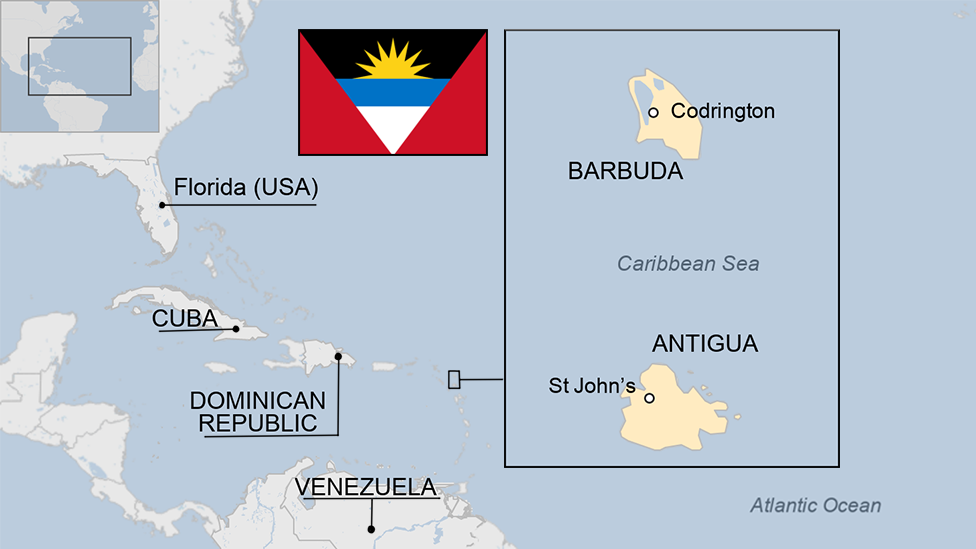October 2025 Global Mobility News: New U.S. Citizenship Test, EU Border System Launches, China's K-Visa for STEM Talent
Global mobility updates you should not miss this month
Each month I track new visas, residency changes, and travel rules that can affect where you go or what you pay.
Visa launches
Rule and fee changes
Travel access changes
Citizenship & investment news
One short question for reflection
Here is what changed in the last four weeks.
New Visas
China’s K-Visa for Young STEM Talent
On October 1, 2025, China launched its K-visa program targeting young foreign professionals in science, technology, engineering, and mathematics (STEM) fields.
The visa allows holders to enter China without employer sponsorship and offers long-term residency options, tax benefits, housing support, and access to international schools for dependents.
Key points:
Launched Oct 1, 2025.
For young STEM graduates from recognized universities worldwide.
No employer sponsorship required.
Flexible entry and multiple activities permitted.
Interesting timing. China rolled out the K-visa just weeks after the U.S. imposed a $100,000 fee on new H-1B petitions in September 2025, creating a stark contrast in how the two countries approach global talent.
Rule and Fee Changes
U.S. Naturalization Test Gets Harder
On October 20, 2025, the United States implemented a tougher citizenship test for green card holders seeking naturalization. Applicants filing Form N-400 on or after this date now face a revised 2025 Naturalization Civics Test with more challenging questions and higher passing requirements.
What changed:
Question pool expanded to 128 questions (from previous version)
Applicants must answer 20 questions correctly out of 20 asked (up from 10 questions asked previously)
Minimum passing score: 12 correct answers (60%)
The test also includes stricter “good moral character” assessments.
Immigration officers now look for positive contributions to American society, not just the absence of bad behavior. Officers may interview co-workers, family members, or neighbors as part of background checks.
UK Adds 82 Occupations to Temporary Work Visa List
In October 2025, the UK added 82 new occupations to its Temporary Work Visa Shortage List, covering roles in logistics, engineering, translation, and manufacturing.
The goal is to fill ongoing labor gaps by allowing overseas workers to take up mid-skill roles on 3-5 year visas.
However, these visas won’t lead directly to permanent residency.
The update aims to support employers struggling to find local talent, though it has sparked mixed reactions.
Critics argue that expanding visa pathways could heighten concerns around immigration levels, while others see it as necessary to sustain the UK’s productivity and growth.
UK Graduate Route Duration Cut
From January 1, 2027, the UK’s Graduate Route visa will shrink from 24 months to 18 months for bachelor’s and master’s degree holders. PhD graduates will still receive 36 months.
The change gives international students less time to work in the UK after graduation before switching to another visa category like Skilled Worker or Global Talent.
The full visa-guide to immigrating to the UK can be found here:
UK English Language Requirement Raised
From January 8, 2026, English language requirements for Skilled Worker, Scale-up, and High Potential Individual visa applicants will increase to B2 level (upper intermediate), up from the current B1 level (intermediate).
UK High Potential Individual Route Expands (But Caps)
From November 4, 2025, graduates from universities ranked in the global top 100 will be eligible for the High Potential Individual (HPI) visa, expanding beyond the current list of 42 universities.
However, a cap of 8,000 visas per year will be introduced, running from November 1 to October 31 each year.
The HPI visa allows graduates of top universities to work in the UK for up to three years without sponsorship, with no minimum salary or skill level requirements.
Travel Access Changes
EU Entry/Exit System Launches
On October 12, 2025, the European Union began rolling out its Entry/Exit System (EES) across 29 European countries.
The system replaces passport stamps with digital biometric records for non-EU travelers entering the Schengen Area.
How it works:
Non-EU travelers register fingerprints and facial images at automated kiosks or border control booths on their first entry.
The system creates a digital record linked to their passport, valid for three years.
Future trips use facial recognition for faster processing.
Covers all Schengen countries plus Iceland, Liechtenstein, Norway, and Switzerland.
The rollout is progressive over six months, with full implementation expected by April 10, 2026.
During the transition period, manual passport stamping continues alongside EES registration.
Countries covered: Austria, Belgium, Bulgaria, Croatia, Czech Republic, Denmark, Estonia, Finland, France, Germany, Greece, Hungary, Iceland, Italy, Latvia, Liechtenstein, Lithuania, Luxembourg, Malta, Netherlands, Norway, Poland, Portugal, Romania, Slovakia, Slovenia, Spain, Sweden, and Switzerland.
The EES aims to prevent overstays, detect document fraud, and strengthen border security.
Travelers may experience longer wait times during the initial rollout period, particularly at peak times.
Citizenship & Investment News
Antigua and Barbuda Reforms Citizenship Program
In October 2025, Antigua and Barbuda introduced new reforms to its Citizenship by Investment Program (CIP), marking a significant modernization of the Caribbean investment citizenship framework.
Key changes:
New citizens must spend 30 days in Antigua and Barbuda within five years (up from five days previously)
Mandatory formal interview for all new applicants (in person or virtual)
Biometric data required when renewing passports
The 30-day requirement remains flexible and can be spread across multiple visits.
The reforms aim to enhance transparency, credibility, and international compliance, aligning with standards set by the U.S., Canada, UK, and European Union.
Antigua and Barbuda is working closely with other Organization of Eastern Caribbean States (OECS) members, including St. Kitts and Nevis, Saint Lucia, Dominica, and Grenada, to align practices and implementation timelines.
For individuals who already hold Antigua and Barbuda citizenship, all rights and benefits remain unchanged.
The only adjustment concerns submitting biometric data when renewing a passport.
My view: 30 days over five years is six days annually. If you think that transforms buying citizenship into genuine residency, I have a bridge in Antigua to sell you.
Most Read on Digital Citizen in October 2025
How U.S. Citizens Can Move to Canada (Residency & Citizenship Explained) was the most read post this month. It covered visa routes, residency steps, and what daily life actually looks like once you land.
Over 4,800 of you tuned in, showing just how much interest there is in Canada as a relocation option.
Thanks again for your support.
One Question For You
When you think about moving abroad, did you ever make a list of things you’re expecting from your next country?
For me, this is what I would write down today:
Good weather
Great people
Good energy
Safe streets
What’s on your list?
If this brief helps to give you clarity, share it with someone that it could also benefit.
And if you have questions about your specific situation, drop them in the comments.
I read them all.
PS
And if you don’t want to figure this out alone, I offer 1:1 support.
Appreciate you being here,
— Ben











Thank you for this!